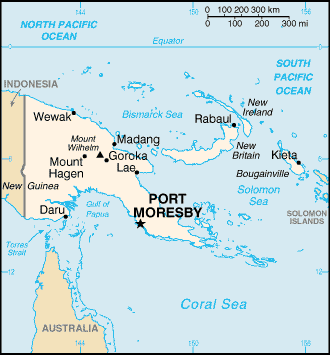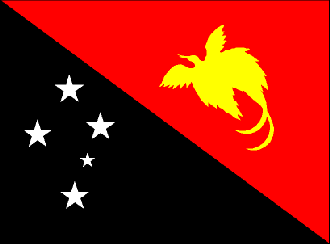|
 |
Papua New Guinea
Background: The eastern half of the island of New Guinea - second
largest in the world - was divided between Germany (north) and the UK (south) in 1885. The latter area was transferred to
Australia in 1902, which occupied the northern portion during World War I and continued to administer the combined areas until
independence in 1975. A nine-year secessionist revolt on the island of Bougainville ended in 1997, after claiming some 20,000
lives.
Location: Southeastern Asia, group of islands including the eastern
half of the island of New Guinea between the Coral Sea and the South Pacific Ocean, east of Indonesia. Area - comparative:
Slightly larger than California. Coastline: 5,152 km.
Climate and Terrain: Tropical;
northwest monsoon (December to March), southeast monsoon (May to October); slight seasonal temperature variation. Mostly mountains
with coastal lowlands and rolling foothills. Elevation extremes: Lowest point: Pacific Ocean 0 m, highest point:
Mount Wilhelm 4,509 m. Natural resources: Gold, copper, silver, natural gas, timber, oil, fisheries. Land use: Arable land:
0.1%, forests and woodland: 92.9%, other: 6%.
People: Population:
5,049,055. Ethnic groups: Melanesian, Papuan, Negrito, Micronesian, Polynesian. Religions: Roman Catholic 22%, Lutheran 16%,
Presbyterian/Methodist/London Missionary Society 8%, Anglican 5%, Evangelical Alliance 4%, Seventh-Day Adventist 1%, other
Protestant 10%, indigenous beliefs 34%/ Languages: English spoken by 1%-2%, 715 indigenous languages.
Government: Capital: The Settlement.
Economy overview:
Papua New Guinea is richly endowed with natural resources, but exploitation has been hampered by the rugged
terrain and the high cost of developing infrastructure. Agriculture provides a subsistence livelihood for 85% of the population.
Mineral deposits, including oil, copper, and gold, account for 72% of export earnings. Agriculture - products: Coffee, cocoa,
coconuts, palm kernels, tea, rubber, sweet potatoes, fruit, vegetables; poultry, pork.
Statistics:
Telephones - main lines in use: 47,000. Telephones - mobile cellular: 3,053. Radio broadcast stations: AM 8,
FM 19, shortwave 28. Radios: 410,000. Television broadcast stations: 3. Televisions: 42,000. Internet country code: .pg Internet
users: 2,000. Railways: 0 km. Highways: Total: 19,600 km, paved: 686 km, unpaved: 18,914 km. Waterways:
10,940 km. Airports - with paved runways: 20, with unpaved runways: 472.
Return to Visiting Locations |
 |
| The Papua New Guinea flag |
|
